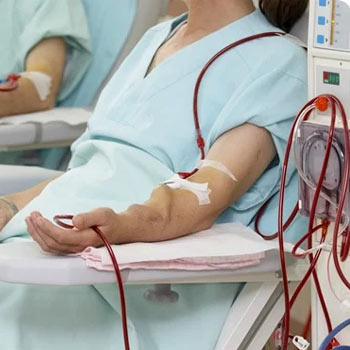Renal Replacement Therapy
- Home
- Services
- Critical Care Medicine
- Renal Replacement Therapy
What is Renal Replacement Therapy?
Renal Replacement Therapy (RRT) is a medical procedure used to replace the function of the kidneys in patients with severe kidney failure or end-stage renal disease (ESRD). The kidneys are vital organs that filter waste products and excess fluids from the blood, maintaining a healthy balance of electrolytes. When the kidneys fail, these functions are compromised, leading to the accumulation of toxins and fluids in the body, which can be life-threatening. RRT is essential in such situations to sustain life and improve the quality of life for patients
What are the types of Renal Replacement Therapy?
Hemodialysis
This is the most common form of RRT. It involves using a dialyzer, also known as an artificial kidney, to filter waste and excess fluids from the blood. The patient's blood is pumped through the dialyzer, where it is cleaned before being returned to the body. Hemodialysis is typically performed in a dialysis center, but home hemodialysis options are also available. Treatment sessions usually last about four hours and are required three times a week.
Peritoneal Dialysis
This method uses the patient's peritoneum (a membrane in the abdomen) as a filter to clean the blood. A dialysis solution is introduced into the abdominal cavity through a catheter, where it absorbs waste products and excess fluids from the blood vessels in the peritoneal membrane. After a set dwell time, the solution is drained, and a fresh solution is introduced. Peritoneal dialysis can be done at home and offers more flexibility, allowing patients to continue with their daily activities
Continuous Renal Replacement Therapy (CRRT)
This is typically used in critically ill patients, often in an intensive care unit (ICU) setting. CRRT is a slower and continuous form of dialysis, making it gentler and better suited for patients with unstable hemodynamics. It operates 24 hours a day, providing continuous removal of waste products and fluid. CRRT includes several modalities such as continuous venovenous hemofiltration (CVVH), continuous venovenous hemodialysis (CVVHD), and continuous venovenous hemodiafiltration (CVVHDF)
Kidney Transplant
This is considered the best long-term solution for patients with end-stage renal disease. A kidney transplant involves surgically placing a healthy kidney from a donor into the patient's body. The new kidney takes over the functions of the failed kidneys. Successful transplantation can significantly improve the quality of life and life expectancy compared to dialysis. However, it requires a suitable donor match and lifelong immunosuppressive medications to prevent rejection

Treatment Methods in Renal Replacement Therapy
Hemodialysis Procedure
Vascular Access
A vascular access point is necessary for hemodialysis. This can be an arteriovenous (AV) fistula, AV graft, or a central venous catheter. The choice depends on the patient's condition and the expected duration of dialysis.
Dialysis Session
During a hemodialysis session, the patient's blood is drawn out through the vascular access and passed through the dialyzer. Inside the dialyzer, the blood flows through thin fibers that allow waste and excess fluid to pass into the dialysis solution. The cleaned blood is then returned to the patient’s body
Peritoneal Dialysis Procedure
Catheter Insertion
A catheter is surgically inserted into the patient's abdomen to provide access to the peritoneal cavity.
Dialysis Solution Exchange
The dialysis solution is introduced into the peritoneal cavity through the catheter. It remains in the cavity for a specified period, allowing waste products and fluids to diffuse into the solution. After the dwell time, the solution is drained and replaced with fresh solution. This process is repeated several times a day in continuous ambulatory peritoneal dialysis (CAPD) or automated at night in automated peritoneal dialysis (APD).
Continuous Renal Replacement Therapy
Continuous Operation
CRRT is performed continuously over 24 hours, providing a gentler and more gradual removal of waste products and fluids. It requires specialized machines and monitoring in an ICU setting.
Kidney Transplant Procedure
Donor Kidney
A healthy kidney from a deceased or living donor is transplanted into the patient
Post-Transplant Care
Patients require lifelong immunosuppressive therapy to prevent the body from rejecting the new kidney. Regular follow-up is essential to monitor kidney function and manage potential complications
Renal Replacement Therapy is a lifesaving treatment for patients with severe kidney failure. The choice of RRT modality depends on the patient's medical condition, lifestyle, and personal preferences. Each method has its advantages and considerations, and a healthcare team will help determine the most suitable option for the patient. Proper management and adherence to treatment protocols are crucial for improving outcomes and enhancing the quality of life for patients undergoing RRT.
